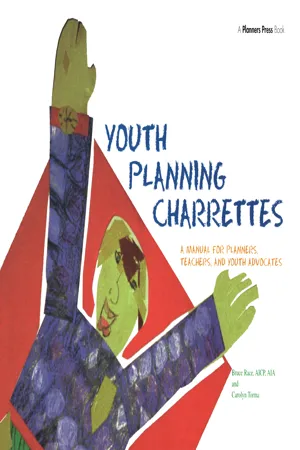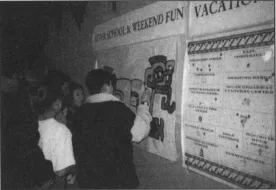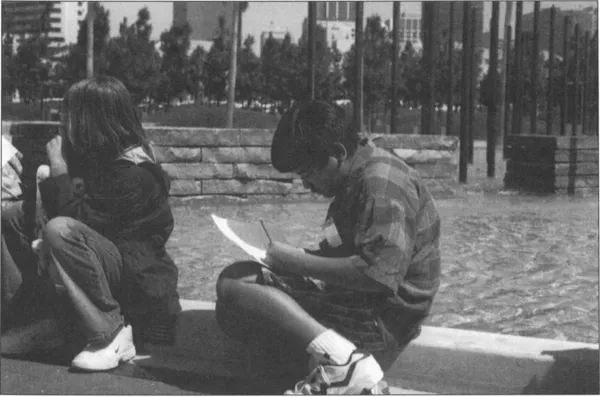
eBook - ePub
Youth Planning Charrettes
A Manual for Planners, Teachers, and Youth Advocates
This is a test
- 95 pages
- English
- ePUB (mobile friendly)
- Available on iOS & Android
eBook - ePub
Book details
Book preview
Table of contents
Citations
About This Book
Invest in the future! Involve young people in planning. Learn how to design charrettes, starting with workshops and ending with lessons learned.
This book explores various approaches to involving youth in schools, museums, and citizen groups. It's a complete guide to successful community charrettes for younger participants (K-8).
First published in 1998. Routledge is an imprint of Taylor & Francis, an informa company.
Frequently asked questions
At the moment all of our mobile-responsive ePub books are available to download via the app. Most of our PDFs are also available to download and we're working on making the final remaining ones downloadable now. Learn more here.
Both plans give you full access to the library and all of Perlego’s features. The only differences are the price and subscription period: With the annual plan you’ll save around 30% compared to 12 months on the monthly plan.
We are an online textbook subscription service, where you can get access to an entire online library for less than the price of a single book per month. With over 1 million books across 1000+ topics, we’ve got you covered! Learn more here.
Look out for the read-aloud symbol on your next book to see if you can listen to it. The read-aloud tool reads text aloud for you, highlighting the text as it is being read. You can pause it, speed it up and slow it down. Learn more here.
Yes, you can access Youth Planning Charrettes by Bruce Race in PDF and/or ePUB format, as well as other popular books in Architecture & Urban Planning & Landscaping. We have over one million books available in our catalogue for you to explore.
Information
CHAPTER 1
CASE STUDIES: LEARNING. LIVING AND ADVOCACY
There are a variety of reasons to get youth involved in community planning. Educators want to introduce active civic learning into the classroom. Community planners and policymakers reach out for a more inclusive view of their communities by integrating youth concerns. Communities and parents seek an informed atmosphere for citizenship and leadership training. And young people want their aspirations acknowledged in preparing plans for the future.
AGE GROUPS FOR USING CHARRETTES: 5TH GRADE THROUGH ADULT
While young people of any age can participate in planning education projects, the charrette method works best with children who are already at an age where they can work cooperatively, complete a series of different tasks both individually and in a group, and articulate the results of their insights. Therefore, it is unlikely a charrette would work well with children below the 5th grade level.
There is no upper age limit to who can participate in charrettes. Indeed, a charrette that combined youth and senior adults might be among the most exciting a planner or teacher could devise. In planning processes, it is common for planners to separate charrette participants into adult and youth groups. However, Roger Hart, in his insightful book, Children’s Participation: The Theory and Practice of Involving Young Citizens in Community Development and Environmental Care, advocates strongly for developing youth programs that include adults or that mix young people of different ages.
YOUTH CHARRETTES IN TEACHING
Using charrettes to augment the standard educational curriculum in schools and other educational institutions offers an opportunity to provide a boost to the educational objectives. In a focused effort, it incorporates other professional and community participants and blends learning with active citizenship activities. From elementary students to high school students, special events and charrettes can add value and richness to the classroom experience. For teachers of civics or government, design or art, history or social studies, special events that allow students to focus on a particular place and issue can be a very effective way to make the lesson real.
When using a charrette, the educational objectives will vary from place to place; however, charrette events offer an occasion for others to get involved in the educational process. Some of the added benefits of conducting charrettes are that students will be mentored by the volunteer participants, as well as exposed to new career opportunities, and introduced to civic role models. Volunteers for these programs can include planners, architects, landscape architects, engineers, politicians, public safety professionals, business people, artists, and elected officials.

In the case studies presented here, some schools shared resources to undertake this type of event. They also took advantage of nonprofit institutions that specialize in augmenting school curriculum. For example, in the New York and San Francisco areas there are Architects-in-the-School programs that focus on environmental design education. In Utah and Indiana, planners conduct Planners Day in Schools programs.
There are many community-based organizations (CBOs) and institutions involved in youth development. These organizations provide ongoing after-school programs that augment classroom activities. They stress citizenship development and cultural enrichment of young people. Many of these organizations emphasize empowerment, which they define as providing knowledge and motivating young people to “take ownership” of projects and communities. They are committed to the belief that youth can help change their communities for the better. In San Francisco, St. Johns Urban Institute illustrates how these organizations use charrettes. The goal is to immerse young people in curriculums that will increase their understanding of their community and create concrete projects that improve neighborhoods for youth and families.
CASE STUDIES
Wherever youth are engaged in a charrette process there is a tremendous opportunity to provide a learning experience. Educators have found the hands-on and experienced-based qualities of a charrette can offer an intensive educational opportunity. This happens in schools, museums, and other community-based organizations that stress enhancing young peoples’ communication skills and understanding of urban issues.
Museum-Based Case Studies
Many museums have sponsored workshops. Included in our case study examples are the APA’s 1997 Kids’ Planning Charrette in San Diego; and Cooper Hewitt Museum, National Design Museum, and the New York Chapter of the American Institute of Architects ongoing “A City of Neighborhoods—Bridging School and Community” program.

CASE STUDY 1 KIDS’ PLANNING CHARRETTE
American Planning Association and the San Diego Children’s Museum April 1997
Mass transit in the form of kidmobiles and light industry in the form of a chocolate factory—those were some of the ideas that came out of the charrette to redesign the neighborhood surrounding the San Diego Children’s Museum into a kid-friendly neighborhood.
This case study illustrates a strictly educational charrette. With more time devoted to the project, the charrette could easily have been integrated into a planning process. However, the goal in this case was to teach planners how to conduct charrettes, with the students serving as “instructors” on the process.

Who
APA members and staff created the charrette. The one-day event brought planners, several teachers and the 5th and 6th grades from the Zamorano Elementary School together for the planning event. In this charrette the roles broke down into: 3 facilitators; 3 staff, 30 planners/kids’ assistants, 3 teachers, and 65 students.
Context
The event was held as both an education workshop and a community outreach event as part of the 1997 APA National Planning Conference in San Diego. The event took place in the San Diego Children’s Museum, a wonderful, sunny, colorful, and open space in which the students worked in groups at tables. Museum staff provided support in setting up the event.
Goals
◆Introduce planners to the principles of conducting a charrette with a youth group.
◆Demonstrate how planning concepts could be made into a problem-solving educational event.
◆Provide elementary school students a one-day introduction to planning issues and concepts in terms of their own community.
◆Acquaint teachers in the San Diego school system with an educational enrichment program on city planning.
How
The day had three major segments. The entire event took place between 8:30 a.m. and 4:30 p.m., with the students arriving at 9:30 a.m. and leaving at 2:00 p.m. This was the agenda:
◆Introduction and orientation for planners
◆Charrette with students
Exercise one: cognitive mapping and drawing your neighborhood Debriefing
Exercise two: environmental walk and mapping of museum neighborhood
Exercise three: neighborhood design game Reporting: three big and cool ideas
Exercise four: designing a kids’ charrette in your own community
◆Debriefing for pla...
Table of contents
- Cover
- Title Page
- Copyright Page
- Table of Contents
- Foreword
- Chapter 1 Case Studies
- Chapter 2 Getting Ready for Workshops and Charrettes
- Chapter 3 Facilitating the Charrette
- Chapter 4 Recording the Results
- Chapter 5 Using the Results
- Chapter 6 Lessons Learned
- Chapter 7 Designing your Own Kids’ Charrette
- Bibliography
- Illustration Credits